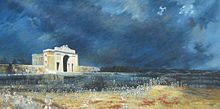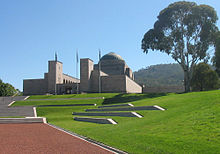Australian War Memorial
The Australian War Memorial ( AWM ; German Australian War Memorial ) in Canberra is Australia's national war memorial . It commemorates those members of the Australian Defense Force and supporting organizations who fell in the wars in which Australia participated.
Located in the Campbell neighborhood, it forms part of the ceremonial land axis that runs from Parliament House on Capital Hill to the summit of Mount Ainslie . There is no direct road connection, but it is possible to see the AWM from Parliament in a direct line of sight, and vice versa. The AWM consists of four elements; the ANZAC Parade, a memorial area, a museum and a sculpture garden.
ANZAC parade
The ANZAC Parade is a short wide street that in honor of the Australian and New Zealand Army Corps was named. It stretches from the north bank of Lake Burley Griffin to the actual monument and lies exactly on the line of sight that leads to Parliament. On both sides of the parade there are a number of memorials commemorating various Australian military operations or honoring military branches. Several styles from naturalistic to modern are represented.
This part of the monument also serves to symbolize the friendly relations between Australia and New Zealand . The middle of the road is adorned with borders of flat, New Zealand lifting bushes . The symbolic bond between the two countries continues with two almost identical monuments in the form of a basket handle, which are reminiscent of a Māori proverb : "Mau tena kiwai o te kete, maku tenei" (you hold one handle of the basket, I hold the other) . The street is lined with eucalyptus trees on both sides , which demarcate the neighboring residential areas.
Memory area
The actual memorial is located on a pear-shaped meadow at the northern end of the ANZAC Parade. The museum is below and around the memorial area, the sculpture garden on the green space to the west.
The center of the memory area is the Hall of Memory , a domed structure in the shape of an octagon . The walls are made of small mosaic tiles up to the dome . The tomb of the unknown soldier and other monuments are located in this domed structure . The east, west and south walls are adorned with stained glass depicting the characteristics of soldiers. On the four walls, which are aligned to the northeast, southeast and southwest, there are mosaic murals of a soldier, on the northwest wall of a female member of the army.
In front of the Hall of Remembrance is a narrow courtyard with an eternal flame in the middle of a water basin. The basin is flanked by walkways and rosemary bushes . Above the inner courtyard there are long, covered colonnades with the Roll of Honor , bronze plaques with the names of all 102,000 Australian military personnel who lost their lives in action. The entire wall of the western gallery is engraved with the names of those who fell in World War I , the wall of the eastern one with the names of those who died in World War II and later conflicts.
Only names are listed in the directory of honor, but not ranks or awards, since “after death all are equal”. Visitors often put pieces of paper in the gaps between the individual plaques to commemorate their relatives or friends. In the museum it is explicitly pointed out that the breaker Morant, who is revered as a folk hero in Australia, is not listed in the list of honor only because he did not actually belong to the Australian troops during the Boer War .
There is a ceremony every day when the museum closes. Visitors gather at the entrance and, after a brief explanation from a museum employee, listen to the sounds of the song “Last Post” played by the tape in honor of the fallen. On special days, the song is performed by a Clairon or bagpipe player. The Memorial Area and the ANZAC Parade are the places in Canberra where the ANZAC Day and Memorial Day ceremonies take place. Members of parliament and ambassadors, especially from New Zealand, are usually present at these.
museum
The AWM museum is a two-story building with a cross-shaped floor plan, below and around the inner courtyard with the memory area. The building is in the style of Byzantine architecture and has Art Deco decorations throughout. The upper floor is mainly dedicated to World War I (entire west wing, with a focus on the Battle of Gallipoli ) and World War II (entire east wing).
Between the two wings is the Aircraft Hall , in which some aircraft from the Second World War are exhibited. Also between the wings is the Hall of Valor with an exhibition of almost all of the Victoria Crosses ever bestowed on Australian soldiers. These 60 medals are the largest publicly accessible collection of Victoria Crosses in the world. In addition, each holder of this order is briefly introduced. The relatives of the medal winners donate or in many cases lend the medals to the Australian War Memorial in order to keep them in safe custody and to keep the memory alive. On the lower floor there is a theater, a research area, exhibitions on the conflicts of the colonial era and the period after the Second World War, as well as an area for temporary special exhibitions.
The ANZAC Hall is a large annex in the south where large war equipment is exhibited. These include an Avro Lancaster bomber , a small Japanese type A submarine , which carried out an attack on Sydney Harbor in 1942 and afterwards a boat was arranged as a diorama from two sunk copies (M14 and M21), German fighter planes of the type Me 262 and Me 163 as well as a Mark I tank.
On the occasion of the commemoration of the First World War, the only surviving example of the German A7V tank was moved from the Queensland Museum to the exhibition in June 2015 (until April 2017).
Sculpture garden
In the sculpture garden on the west side of the monument there are various monuments. In the sidewalk that leads through the garden, bronze plaques are embedded that remind of military branches, specific units and historical events. The sculptures on display include a gigantic representation of an Australian soldier during the First World War. This was originally in the Hall of Memory before the grave of the unknown soldier was placed there. Also on display there are a turret from the destroyer HMAS Brisbane , a cannon from the heavy cruiser HMAS Australia and a railway gun stolen by the Germans during the First World War . This area is also used for special exhibitions and concerts are held in summer.
History of the monument
Charles Bean , the official Australian historian for World War I, first came up with the idea of building a memorial in honor of Australian soldiers in 1916 while watching the battles in France. In 1917 the Australian War Records Section was created to protect the records made during the war for posterity. These were first exhibited in Melbourne and later in Sydney .
In 1927 an architectural competition was held to build a national monument in Canberra, but the commission responsible did not determine a winner. Instead, two contestants were encouraged to pool their designs. Limited funds and the consequences of the global economic crisis led to a downsizing of the construction project. Eventually the building opened in 1941; some extensions followed.
Web links
- Australian War Memorial (English)
- Roll of Honor ( honorary role of the AWM)
- Australian War Memorial at Google Cultural Institute
See also
Coordinates: 35 ° 16 ′ 49 ″ S , 149 ° 8 ′ 55 ″ E
Single references
- ^ Australian War Memorial: Mephisto ; Queensland Museum: Fact Sheet (PDF) .






